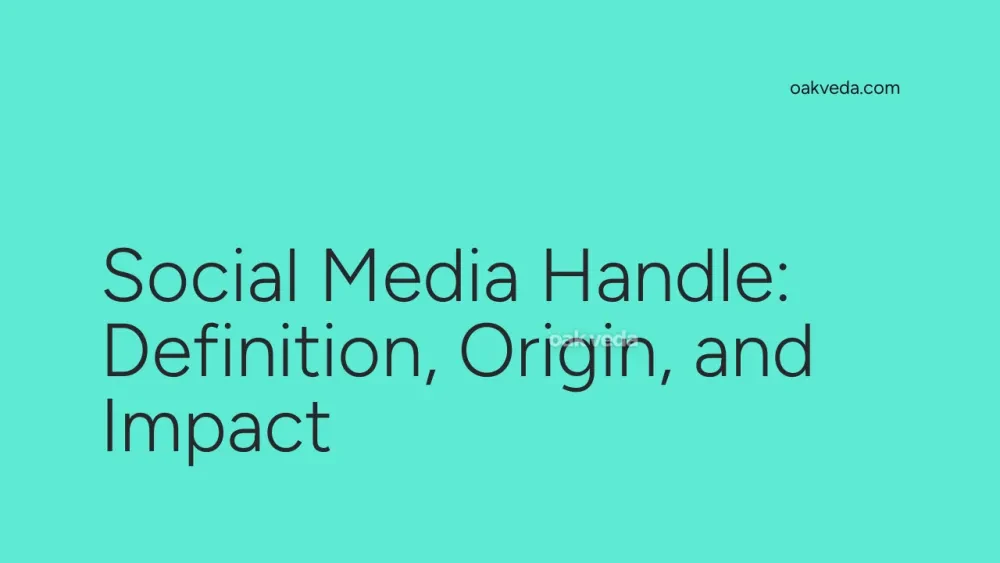
What is a Social Media Handle?
A social media handle is a unique identifier used on various social media platforms to represent individuals, businesses, or organizations. It's typically preceded by the "@" symbol and consists of a combination of letters, numbers, and sometimes special characters. Think of it as your digital username or nickname in the vast world of social networking.
Social media handles serve multiple purposes:
- They make it easy for users to find and mention each other
- They create a consistent brand identity across platforms
- They can be used to tag users in posts, comments, and messages
For example, on Twitter, you might see @elonmusk, while on Instagram, a fashion brand could be @zara. These handles are crucial for navigation and interaction within social media ecosystems.
Origin and Development of Social Media Handles
The concept of handles predates social media, originating in early internet chat rooms and forums. However, they gained prominence with the rise of social networking sites in the early 2000s. Twitter, launched in 2006, popularized the use of the "@" symbol before handles, making them easily distinguishable within tweets.
As social media evolved, handles became increasingly important for personal branding and business marketing. They transitioned from simple identifiers to valuable digital assets, with some handles even being sold for substantial sums.
How Social Media Handles Work
Social media handles function as unique identifiers within each platform. Here's how they typically work:
- Uniqueness: Each handle must be unique within a platform, ensuring no two users have the same identifier.
- Tagging: Users can mention or tag others using their handles, notifying them and creating links to their profiles.
- Search: Handles are searchable, allowing users to find specific accounts easily.
- Profile URLs: Many platforms use handles to create profile URLs (e.g., twitter.com/username).
Types or Variations of Social Media Handles
While the basic concept remains the same, handles can vary slightly across platforms:
- Twitter: Uses "@username" format, limited to 15 characters
- Instagram: Also uses "@username", but allows up to 30 characters
- Facebook: Uses custom URLs (facebook.com/username) for pages and profiles
- LinkedIn: Allows custom URL slugs for personal profiles
- TikTok: Uses "@username" format, similar to Twitter and Instagram
Popular Examples of Social Media Handles
Some notable social media handles include:
- @NASA (NASA's official Twitter account)
- @therock (Dwayne "The Rock" Johnson on Instagram)
- @garyvee (Gary Vaynerchuk across multiple platforms)
- @natgeo (National Geographic on various social media)
These handles are memorable, concise, and effectively represent their respective brands or personalities.
Impact of Social Media Handles on Social Media Culture
Social media handles have significantly influenced online culture:
- Digital Identity: Handles have become an extension of personal and brand identities.
- Verification: Many platforms use blue checkmarks to verify notable handles, creating a status symbol.
- Hashtag Culture: Handles often integrate with hashtags for campaigns and trends.
- Cross-Platform Consistency: Users strive for consistent handles across platforms for better recognition.
Controversies or Debates Surrounding Social Media Handles
Several issues have arisen regarding social media handles:
- Cybersquatting: Some users register handles of famous names or brands to sell them later.
- Impersonation: Fake accounts using similar handles to impersonate others.
- Handle Hijacking: Hackers targeting valuable handles for theft or ransom.
- Trademark Disputes: Conflicts between trademark owners and handle users.
How Brands and Influencers Use Social Media Handles
Brands and influencers leverage social media handles for various purposes:
- Brand Recognition: Consistent handles across platforms reinforce brand identity.
- Marketing Campaigns: Handles are often central to hashtag campaigns and contests.
- Customer Service: Many brands use dedicated handles for customer support (e.g., @AmazonHelp).
- Influencer Collaborations: Brands often require influencers to tag their handles in sponsored content.
Future Trends Related to Social Media Handles
As social media continues to evolve, we can expect several trends:
- Integration with Web3: Handles may become linked to blockchain-based identities.
- Cross-Platform Unification: Services may emerge to manage handles across multiple platforms.
- AI-Generated Handles: AI might help users create unique, brand-appropriate handles.
- Enhanced Verification: More sophisticated methods to verify handle ownership and authenticity.
FAQs about Social Media Handles
-
How do I choose a good social media handle? Choose something memorable, relevant to your brand or personality, and consistent across platforms.
-
Can I change my social media handle? Most platforms allow handle changes, but it may affect your visibility and follower connections.
-
What if my preferred handle is taken? Try variations with underscores, numbers, or additional words that still represent your brand.
-
Are social media handles case-sensitive? Typically, no. @Username and @username are usually treated the same.
-
How important is it to have the same handle on all platforms? While not crucial, consistency helps with brand recognition and makes it easier for followers to find you across platforms.
In conclusion, social media handles have become an integral part of our online identities. They serve as digital signatures, helping us navigate the complex world of social media while building personal and brand presences. As social platforms continue to evolve, the importance of well-chosen, consistent handles is likely to grow, making them a crucial element of digital strategy for individuals and businesses alike.
You may be interested in:
- User-Generated Content (UGC): Definition, Origin, and Impact
- Simp: Definition, Origin, and Impact on Social Media
- Influencer: Definition, Origin, and Impact on Social Media
- Soft-Launch: Definition, Origin, and Impact on Social Media
- Engagement Rate: Definition, Origin, and Impact
- PFP: Definition, Origin, and Impact on Social Media

